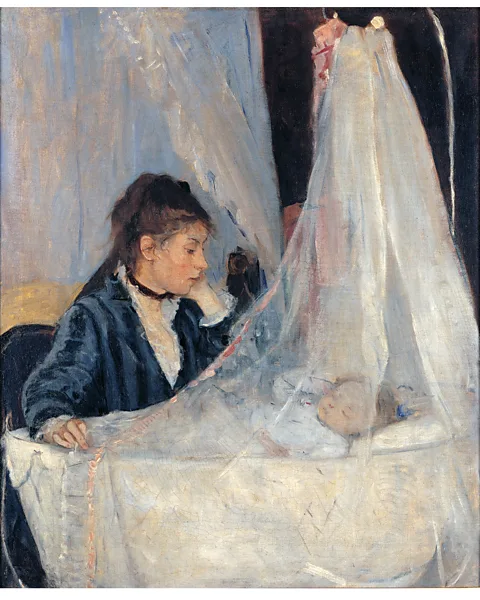
The Cradle: Exploring Morisot's Masterpiece in Art History

The world of art history witnessed a remarkable evolution during the late 19th century, particularly with the emergence of the Impressionist movement. Among the notable masterpieces that defined this period is Berthe Morisot's iconic painting, "The Cradle." Created between 1872 and 1874, this masterpiece not only exemplifies Morisot's artistic prowess but also serves as a profound commentary on motherhood and domestic life, key themes that resonate with contemporary audiences.
Understanding "The Cradle" involves delving into the broader art historical context of the 1870s, a time marked by innovation and experimentation. As artists like Edouard Manet and Paul Cézanne explored new techniques and perspectives, Morisot emerged as a trailblazer in the realm of Impressionism. In this article, we will explore the significance of "The Cradle," from its historical context to its lasting legacy, illuminating why it stands as a remarkable testament to Morisot's unique vision within the art world.
- Historical Context of the 1870s
- Berthe Morisot: A Pioneer of Impressionism
- The Creation of "The Cradle"
- Symbolism and Themes in "The Cradle"
- Comparison with Contemporary Works
- The Impact of "The Cradle" on Art History
- Reception and Legacy of Morisot's Masterpiece
- Conclusion: The Enduring Significance of "The Cradle"
Historical Context of the 1870s
The Rise of Impressionism
The 1870s were a transformative decade in art history, as traditional artistic norms began to shatter, giving way to new movements such as Impressionism. This period was characterized by a growing emphasis on capturing momentary effects of light and atmosphere, rather than focusing solely on detailed representations. Artists were drawn to outdoor settings, seeking to portray everyday life with a sense of spontaneity and emotional resonance.
Societal Changes and Artistic Expression
As industrialization spread across Europe, society underwent significant transformations. Urban environments flourished, and the role of women began to evolve, influencing artists like Morisot who often depicted themes related to femininity and domesticity. During this time, the acceptance of new styles at esteemed exhibitions, like the Salon, played a crucial role in shaping an artist’s career, providing a platform for artists such as Morisot and her contemporaries.
Berthe Morisot: A Pioneer of Impressionism
Early Life and Artistic Development
Berthe Morisot was born into a wealthy family in Bourges, France, in 1841. Her privileged upbringing allowed her to cultivate her passion for art, leading her to study under renowned artists and learn techniques that would later influence her signature style. Morisot became acquainted with several Impressionist masters, including Édouard Manet, who not only became a mentor but also a significant influence on her work.
Establishing Her Place in Art History
As a female artist in a male-dominated field, Morisot faced unique challenges. By embracing the Impressionist movement and participating in key exhibitions, she carved out her own niche, earning recognition as one of the leading figures of this avant-garde style. Her technique, characterized by soft brush strokes and a light palette, set her apart and solidified her contributions to the cradle of Impressionism.
The Creation of "The Cradle"
Inspiration and Conceptualization
Created in 1872, "The Cradle" reflects Morisot's intimate experience of motherhood, as she became a mother herself around this time. The work resonates with the profound emotions tied to nurturing and care. Morisot’s choice of a domestic scene, focusing on the mother and child dynamic, was both a reflection of her personal life and a social commentary on women’s roles during the period.
Composition and Techniques
The composition of "The Cradle" encapsulates the feeling of peacefulness and intimacy. The image is framed to draw the viewer's eye towards the cradle, where a sleeping infant rests. Morisot's loose brushwork and use of soft, muted colors evoke feelings of warmth and tenderness. The painting showcases her mastery of light, captivating viewers with the interplay of shadows and illumination that highlights the figures.
Symbolism and Themes in "The Cradle"
The Significance of Motherhood
At its core, "The Cradle" delves deep into the theme of motherhood, portraying both the physical and emotional aspects of this universal experience. The cradle itself symbolizes not only the nurturing aspect of a mother’s love but also the protective environment in which a child thrives. This portrayal invites contemplation on the shared experience of motherhood, resonating with viewers across generations.
Exploration of Femininity
Morisot's work also sheds light on femininity and the often-invisible labor associated with it. By focusing on the domestic sphere, she highlights the important role women played in maintaining family life, countering the dominant narratives of her time that overlooked the significance of women's contributions. The Cradle stands as a celebration of women's experiences and sacrifices, inviting admiration and respect for these often-underappreciated aspects.
Comparison with Contemporary Works
The Cradle vs. Other Impressionist Works
In understanding "The Cradle," it is essential to compare it with other Impressionist works created during the same period. For instance, Edouard Manet's "Gare Saint-Lazare" reflects the hustle and bustle of urban life, contrasting sharply with Morisot's serene and intimate portrayal of domesticity. While both artists were driven by the principles of Impressionism, their subjects and emotional approaches showcase the diverse range of expressions within the movement.
Influence from the Academic Tradition
Morisot's earlier education in classical techniques is also visible in "The Cradle." Unlike many of her contemporaries, who ardently broke away from tradition, Morisot blended academic sensibility with impressionist innovation. This fusion enabled her to navigate her unique artistic identity, allowing her to bring a fresh yet familiar perspective to the canvas.
The Impact of "The Cradle" on Art History
Redefining Female Representation
"The Cradle" played a crucial role in redefining how women were represented in art. By placing a maternal figure at the center of her work, Morisot challenged prevailing stereotypes, suggesting that domestic life was not inferior but rather worthy of admiration and artistic exploration. This shift has significantly influenced how female artists approach their work, highlighting the importance of personal experience and narrative storytelling.
Inspiring Future Generations
The impact of Morisot's masterpiece extends beyond her contemporaries and continues to inspire generations of artists. By championing the theme of motherhood and showcasing intrinsic female experiences, Morisot opened the doors for future female artists to explore subjects that resonate with their identity, ultimately enriching the broader narrative of art history.
Reception and Legacy of Morisot's Masterpiece
Initial Reception
The initial reception of "The Cradle" was mixed, as was the case with many Impressionist works during that time. Some critics lauded Morisot's delicate portrayal and innovative technique, while others struggled to accept the divergence from traditional art forms. Regardless of the criticisms, the painting garnered attention for its emotional depth and technicality, affirming Morisot's rightful place in the art world.
The Enduring Legacy
Today, "The Cradle" is celebrated not only as a standout piece of Impressionist art but also as a significant cultural artifact that sparks conversation around motherhood and women's roles in society. The evolution of Morisot’s reputation over the decades has solidified her position as one of the key figures of the Impressionist movement, paving the way for greater recognition of women artists in art history.
Conclusion: The Enduring Significance of "The Cradle"
In conclusion, Berthe Morisot's "The Cradle" stands as a profound testament to the emotional and cultural complexities of motherhood. Through her unique lens as a female artist in the 19th century, she captured the subtleties of domesticity while challenging societal conventions. As we explore Morisot's masterpiece, we gain insight into not only the evolution of artistic expression but also the changing perceptions of women's roles in society. The enduring significance of "The Cradle" transcends time, reminding us of the power of art to convey deep human experiences and emotions.
Did you find this article helpful? The Cradle: Exploring Morisot's Masterpiece in Art History See more here Education.
Leave a Reply






Related posts